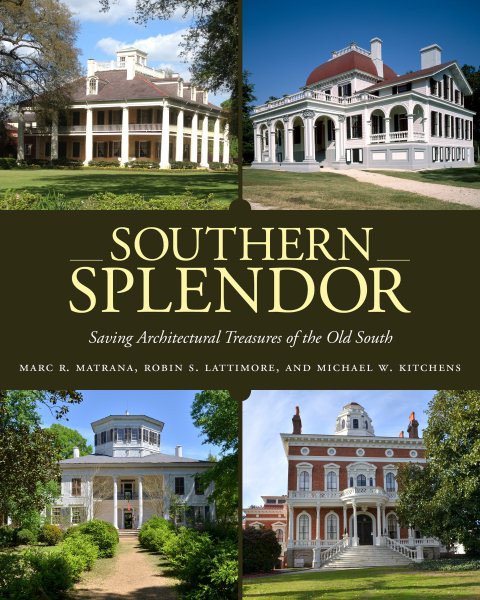By Jordan Nettles. Special to the Clarion-Ledger Sunday print edition (May 6)
In Southern Splendor: Saving Architectural Treasures of the Old South (University Press of Mississippi), historians Marc R. Matrana, Robin S. Lattimore, and Michael W. Kitchens celebrate pre-Civil War homes across the American South. The authors document stories of these homes, with chapters devoted to Louisiana, Mississippi, Alabama, Georgia, Virginia, North Carolina, South Carolina, Kentucky, and Tennessee. The book includes 391 pages and over 275 photographs that showcase the beauty of the historic houses. Selected because of their architectural styles and restoration stories, the nearly fifty homes in Southern Splendor have overcome all types of hardships, from natural disasters and vandalism to abandonment.
The authors document stories of these homes, with chapters devoted to Louisiana, Mississippi, Alabama, Georgia, Virginia, North Carolina, South Carolina, Kentucky, and Tennessee. The book includes 391 pages and over 275 photographs that showcase the beauty of the historic houses. Selected because of their architectural styles and restoration stories, the nearly fifty homes in Southern Splendor have overcome all types of hardships, from natural disasters and vandalism to abandonment.
The walls of every pre-Civil war home have witnessed a myriad of stories, and Southern Splendor captures many fascinating ones. There are accounts of the slave labor that allowed the houses to be built, the lives of the wealthy owners and their families, the tragedies that pressed the homes toward destruction, the restorations that saved them, and the cultural and economic roles the homes now play. These narratives make the homes feel like dynamic characters of history rather than static pieces of the background.
The detailed descriptions of the exterior and interior features are interesting and establish the book as a must-own for any fan of Southern architecture. Accompanying these descriptions are breathtaking photographs of the grand homes. Flip to almost any page, and you’ll find the image of an imposing portico and columns or of an interior room, complete with a striking chandelier and ornate furniture.
As the book notes, the homes of Southern Splendor are “survivors.” Countless other colonial and antebellum homes have not been as fortunate. The authors insist that by letting historic homes deteriorate, we lose vital pieces of the past and irreplaceable resources for understanding our nation’s history. The intersections between these homes and history are extensive.
The book features several homes whose former occupants, such as Thomas Jefferson and Jefferson Davis, are tightly woven into the fabric of American history. Then, there is the strikingly significant Whitney Plantation, a monument and museum of slavery that deals unflinchingly with the South’s difficult history and ensures that the horrors of slavery are never forgotten.
Most of the homes in Southern Splendor are well cared for and open to the public, so it’s hard to believe that many of them were nearly lost forever. Words like “disrepair,” and “dilapidated” are associated with even the most magnificent houses. Without the work of concerned individuals, communities, and organizations, the homes in this book may not exist today.
There’s something exciting about seeing a familiar location celebrated in a book. I have visited the House on Ellicott’s Hill in Natchez and Arlington House in Virginia and enjoyed reading about their histories and architecture. Residents across the South will likely find familiar homes in Southern Splendor. Equally enjoyable is discovering new gems. My personal favorite discovery was Laura House, a unique creole plantation in Louisiana that was run mostly by women.
Southern Splendor brings the included homes to life and makes a solid case for the importance of preservation and restoration. While admiring the beautiful houses, readers will likely find several new destinations to add to their bucket lists.
Jordan Nettles is a graduate of The University of Southern Mississippi and the Columbia Publishing Course in New York.


Comments are closed.